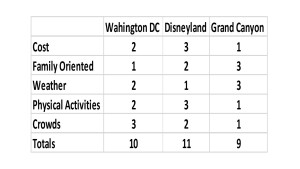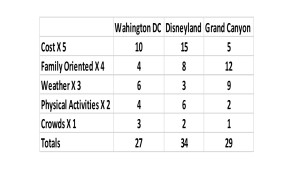Take the blue pill…the story ends, you wake up in bed, and believe what you want to believe
Take the red pill…you stay in Wonderland, and I show you how deep the rabbit hole goes
– Morpheus from the movie “The Matrix”
The memorable “blue pill/red pill” scene from The Matrix offers a powerful image of what we can accomplish when we make a decision to open our minds to new possibilities and act upon deliberate, critical thinking. In this edition of The Critical Doer Deep Dive, I want to share a technique with you that will help you objectively decide upon the appropriate course of action for solving a problem or creating an opportunity. Here’s your last chance to turn back…if you’re still brave enough, let’s “enter the matrix!”
The decision matrix is an analytic technique that allows you to quantify the merits of planning factors across multiple courses of action. The end result is a numeric score that indicates which course of action is most appropriate based upon your prioritization of the planning factors. The added benefit is an answer based upon a repeatable methodology that greatly reduces the cognitive bias error every human brings as baggage into the decision making process. Using the technique will consistently produce better results than thinking based upon emotion, preconceptions, and intuition alone.
The starting point for the decision matrix is a statement of the problem. You may recall from a previous post we covered how to give direction without stifling creativity using mission type orders. In that post, we talked about intent, the “5 w’s of who/what/where/when/why”, identification of important factors to consider and what is/isn’t on the table for planning consideration, and a definition of success. In that post, you may also remember the “Filindablank Family” that was trying to figure out a course of action for a family vacation. Here is their problem statement:
During the last 2 weeks of June 2015, the Filindablank family will take a vacation away from the local area in order to relax, renew family bonds, and provide family enriching opportunities. During planning, elements essential to emphasize are cost, family oriented, weather and physical activities. End State will occur when the vacation is approved and all reservations are made.
Let’s review, starting with the 5 W’s:
- Who: The Filindablank Family
- What: take a vacation
- Where: away from the local area
- When: last 2 weeks of June 2015
- Why: relax, renew family bonds, provide family enriching opportunities
Let’s review the important planning considerations:
- Cost
- Family oriented
- Weather
- Physical activities
Finally, the definition of success: vacation is approved and reservations are made
With a firm understanding of the task and purpose (lest we forget what Albert Einstein once said…”If I had an hour to solve a problem and my life depended on the solution, I would spend the first 55 minutes determining the proper question to ask, for once I know the proper question, I could solve the problem in less than five minutes.”), our fictional family conducted research and came up with 3 potential solutions. Their solutions were Washington DC, Disneyland, and the Grand Canyon.
You’ll notice something is worthy of closer attention about their solutions…the 3 are very distinct (nation’s capital, theme park, great outdoors). In formulating solutions, you must be on guard against cognitive bias that will express a preconceived notion. If you don’t, you will produce 3 solutions but you won’t produce real choices…you will simply produce 3 of the same thing.
After coming up with a set of solutions, I encourage to you to apply something we discussed in a post on Chip and Dan Heath’s book called Decisive. In applying the WRAP model, you should have used the “W” to widen the options and the “R” to reality check…now comes time for the “A”…attain distance (the “P” is prepare to be wrong). In making a conscious effort to attain distance, you can look at your solutions more objectively and determine if you’ve truly achieved distinction or if you produced 3 of the same thing. If you don’t see true distinction, you need to revise your solutions.
The next step is drafting a simple narrative…this step is typically referred to as “the pros and cons.” For each solution, you should simply list the attributes you see as positive and negative. Although it’s possible, it’s rare that any solution doesn’t have a negative aspect. If you find that one of your solutions has no cons, attain distance again and look carefully. It could be a sign that you’re losing objectivity and need to refocus.
With 3 distinct solutions formulated, it really is time now to enter the matrix. The setup is a simple table with the solutions across the top and the planning factors along the side. Simply score each solution 1-n with 1 being the best score. Using our vacationing family as an example, here’s how it looks:
In this example, the Grand Canyon has the lowest score and should be the family’s decision for a vacation…or should it? Let’s suppose that the order of the planning factors accurately reflects the order of importance to this family. In this example and in reality, sometimes an equally weighted model can point you toward a solution based upon high scores on lower tier factors while marginalizing the most important factors.
One way to test for confirmation is through a weighted decision matrix that uses a multiplier for each factor. The multiplier will add a premium value, or weight, the most important factors to amplify their relative importance. The most important factor will receive a multiplier equal to the number of factors (in this case, 5). The next gets a multiplier of 4, etc. In many cases you get the same answer weighted and unweighted; this gives you solid confirmation that you stayed true to your planning guidance and your evaluation process is solid. Sometimes you get a different answer…let’s see what our vacationers found with a weighted matrix:
When weighted, the matrix shows a different preferred solution. When amplifying the most important factors, Washington DC gained an edge over the Grand Canyon. Unweighted, the Grand Canyon held an edge through scoring well on less important factors. In making the decision, it’s legitimate and valid to make decisions based upon either matrix. It is possible that the accumulation of several less important factors can actually be a better solution than one that scores well on the single most important factor.
The decision matrix can be used for any decision, personal or professional. All of my children used this technique in making their college decisions. Their matrices had differences but they used them effectively to come to a very important decision. Evidence thus far indicates all three made the choice that was right for them.
The decision matrix fits nicely with application of critical doer philosophy. As critical doers, we are committed to thinking critically and deeply through a problem to a point where action can begin. An important element of critical thinking is looking at a problem from many perspectives; the decision matrix is a methodical way of capturing those thought processes and consolidating them into a graphic that will lead to the Holy Grail of thinking…action!
I’m sure there’s a situation at home or work where you could benefit from a methodical technique of evaluating solutions to a problem. To see how deep the rabbit hole really goes, enter the matrix and let this technique objectively and methodically turn your thinking into real choices that produce action. It’s what a critical doer would…do!
Reminder: you can get automatic updates from The Critical Doer by using the subscription widget at the bottom of this post. You can also follow on Facebook, Twitter, and Google+. I also encourage you to let me know what you think of the posts or share a story of your own using the comments section or email me directly at [email protected].



1 Comment
Comments are closed.